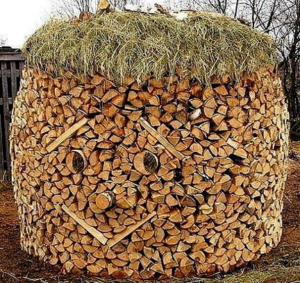“My Stack Is Bigger Than Yours”
 We have been in the business of natural wood homes since 1947. Custom log homes, hand-crafted timber frame homes, cottages, cabins, McMansions. From simple, warm and fuzzy Cedar paneled to way-over-the-top, gnarly, organic log. It’s always been about the wood…and the ones that worked that wood. These, that work with the wood, they are passionate about their art; more religion than job, a good bet probably even over-focused ADHD. A sign in the shop: “The reverence that the object maker has for the materials, for the shape and for the miracle of his skill transcends God, the Master Craftsman, the Creator of all things, who uses us, our hands, as His tools to make these beautiful things.” Literally, generations of these wood artisans have passed through our doors. Their lingo – “Hand scribed log truss. Dove-tail joint. Pocket cut. Swedish cope corner. Hand peeled. Interlocking saddle notch. Beaver tail. Blind mortise-and-tenon joint. Chip carving. Truing. Dado.” But “split and stack”?…
We have been in the business of natural wood homes since 1947. Custom log homes, hand-crafted timber frame homes, cottages, cabins, McMansions. From simple, warm and fuzzy Cedar paneled to way-over-the-top, gnarly, organic log. It’s always been about the wood…and the ones that worked that wood. These, that work with the wood, they are passionate about their art; more religion than job, a good bet probably even over-focused ADHD. A sign in the shop: “The reverence that the object maker has for the materials, for the shape and for the miracle of his skill transcends God, the Master Craftsman, the Creator of all things, who uses us, our hands, as His tools to make these beautiful things.” Literally, generations of these wood artisans have passed through our doors. Their lingo – “Hand scribed log truss. Dove-tail joint. Pocket cut. Swedish cope corner. Hand peeled. Interlocking saddle notch. Beaver tail. Blind mortise-and-tenon joint. Chip carving. Truing. Dado.” But “split and stack”?…
This is not a joke. Anyone who splits and stacks firewood on a regular basis will tell you there is an art to it; a wood pile needs to provide the wood adequate “breathing room” to dry and cure for optimal burning and to prevent mold growth. The stack must also be sturdy enough to stand for months as it gets slowly whittled down during the burning season. In America we stick to a rectangular method often changing the direction of the wood for each layer for optimal air flow. These wood piles are often narrow and long creating easy access to individual pieces while blending into the background of a backyard, porch or deck. Norwegian round — This method builds large rounds of wood formations with barked firewood covering the top of the round pile to protect the underlying firewood from the elements. The German method of stacking firewood, known as the holzhaufen or holz hausen is used to allow air to flow from the outside of the stack into the center to keep all pieces dry. Latvians — well, like anything, three Latvians in a room, five “correct” methods of stacking.
While achieving these standards can require plenty of creativity, there are some folks out there, every bit as passionate as our artisans, who take their wood piles a bit further…



